The thyroid gland in dogs is located in the neck region, much like humans. The gland (thyroid) secretes a hormone called thyroxine that’s involved in metabolism and several other functions involving multiple glands. When the hormone is secreted in lower quantities, experts call the condition hypothyroidism and pet parents often refer to it as thyroid in dogs.
What is Thyroid in Dogs?
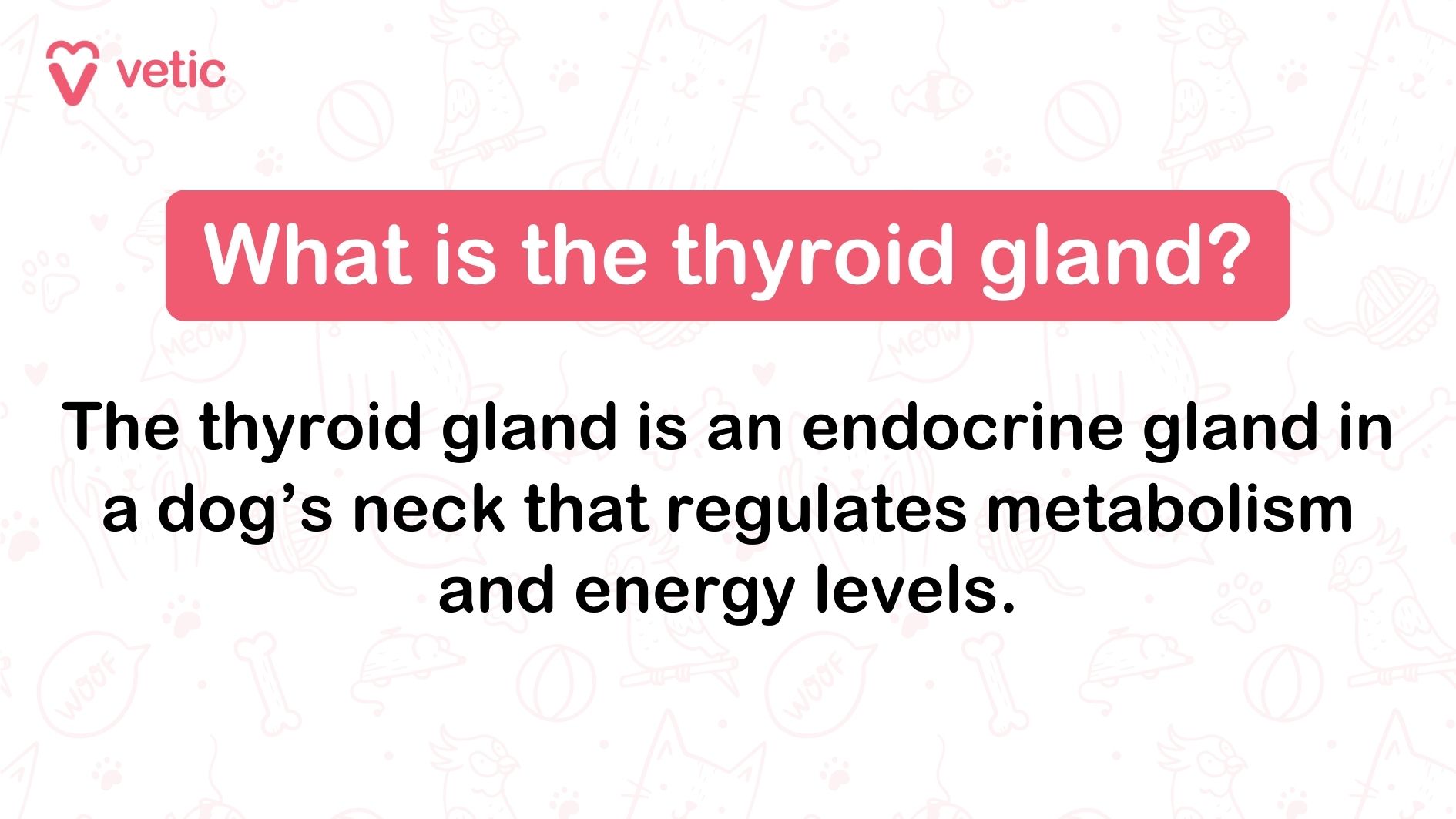
Thyroid in dogs is a very common hormonal imbalance. Hypothyroidism or thyroid in dogs refers to the lower than normal production of thyroid hormone by the thyroid gland.
Since the thyroid hormone controls the metabolism rate, lower levels of the thyroid hormone can disrupt multiple organ functions resulting in lethargy, weight gain, hair loss and skin issues.
What Causes Thyroid in Dogs?
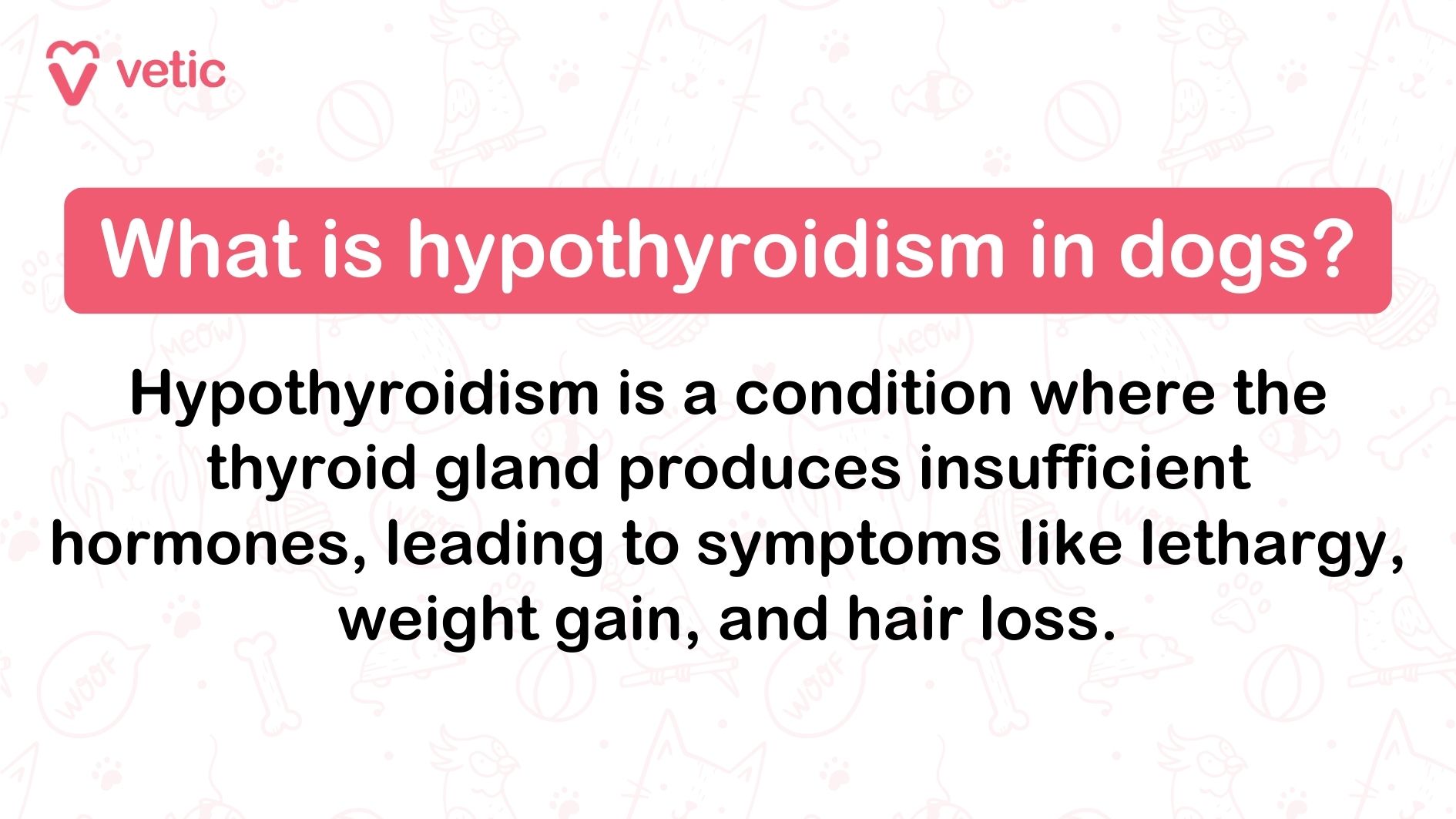
Hypothyroidism or thyroid in dogs caused by the shrinking or inflammation of the thyroid gland. The most common reason for this is autoimmune thyroiditis. Which means, the immune system of the dog’s body attacks the thyroid gland that results in its destruction and inflammation.
Hypothyroidism in dogs is a progressive disease and it results in lower thyroid hormone levels in the system. Iodine deficiency is a common cause of hypothyroidism in dogs who are on homemade meals.
Note: Dogs on high-quality commercial diets are less likely to suffer from hypothyroidism caused by the deficiency of iodine.
What are the Signs of Thyroid in Dogs?
Hypothyroidism or thyroid in dogs can be sneaky in the starting phases. However, it is a chronic and progressive disease, so dogs with hypothyroidism show signs that involve multiple organ systems.
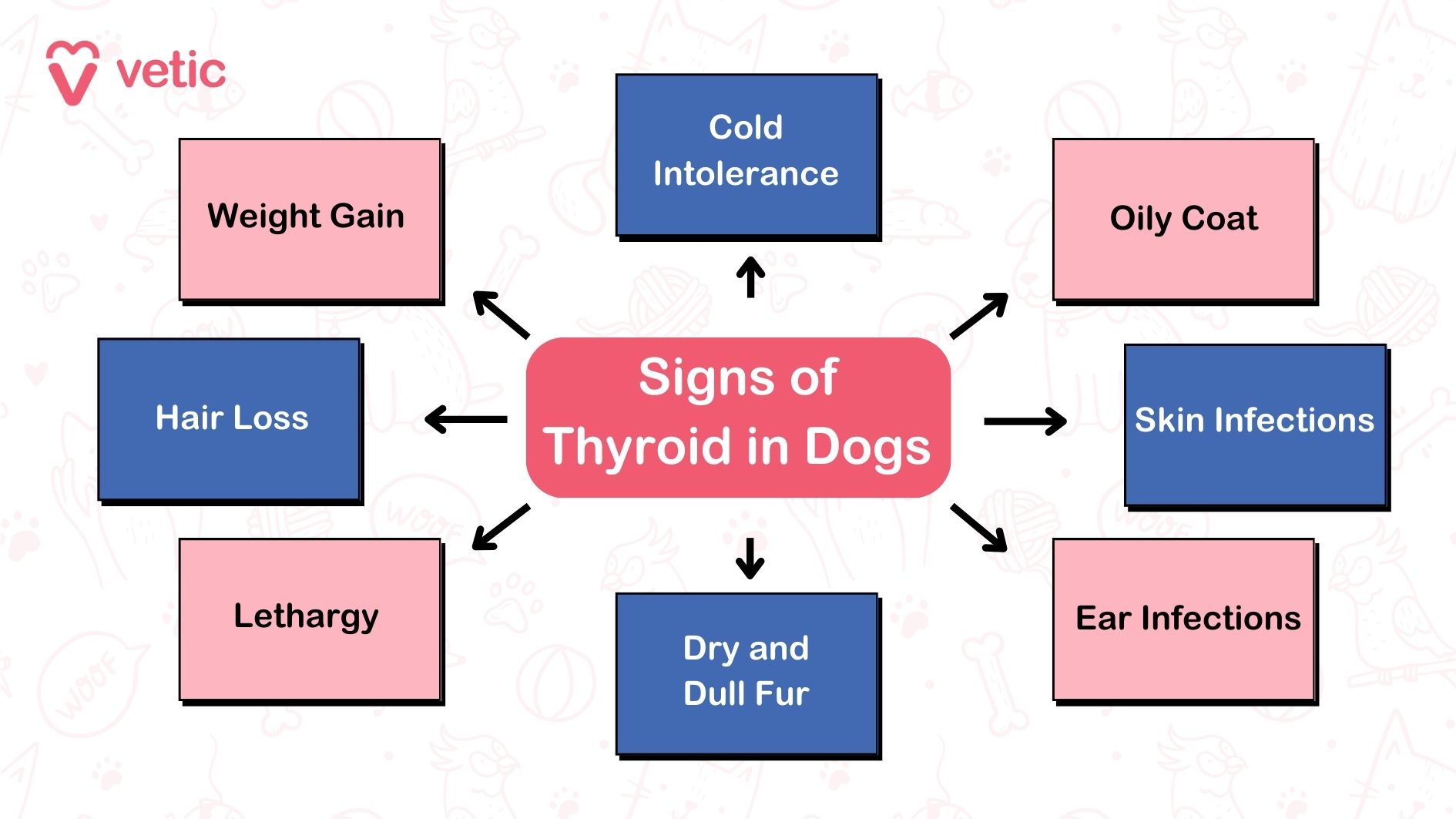
Here are the common signs of thyroid in dogs –
- Reduced activity levels
- Weight gain
- Thinning of fur
- Recurring skin infections
- Recurring ear infections
- Dull and brittle fur coat
- Darkening and thickening of skin
- Low cold tolerance
It is not necessary for dogs to show all these signs. Some dogs with hypothyroidism often show 2 to 3 signs at a time. Changes in their energy levels, appetite and behaviour are the biggest indicators of hypothyroidism.
Is Your Dog at Risk of Thyroid Disease?
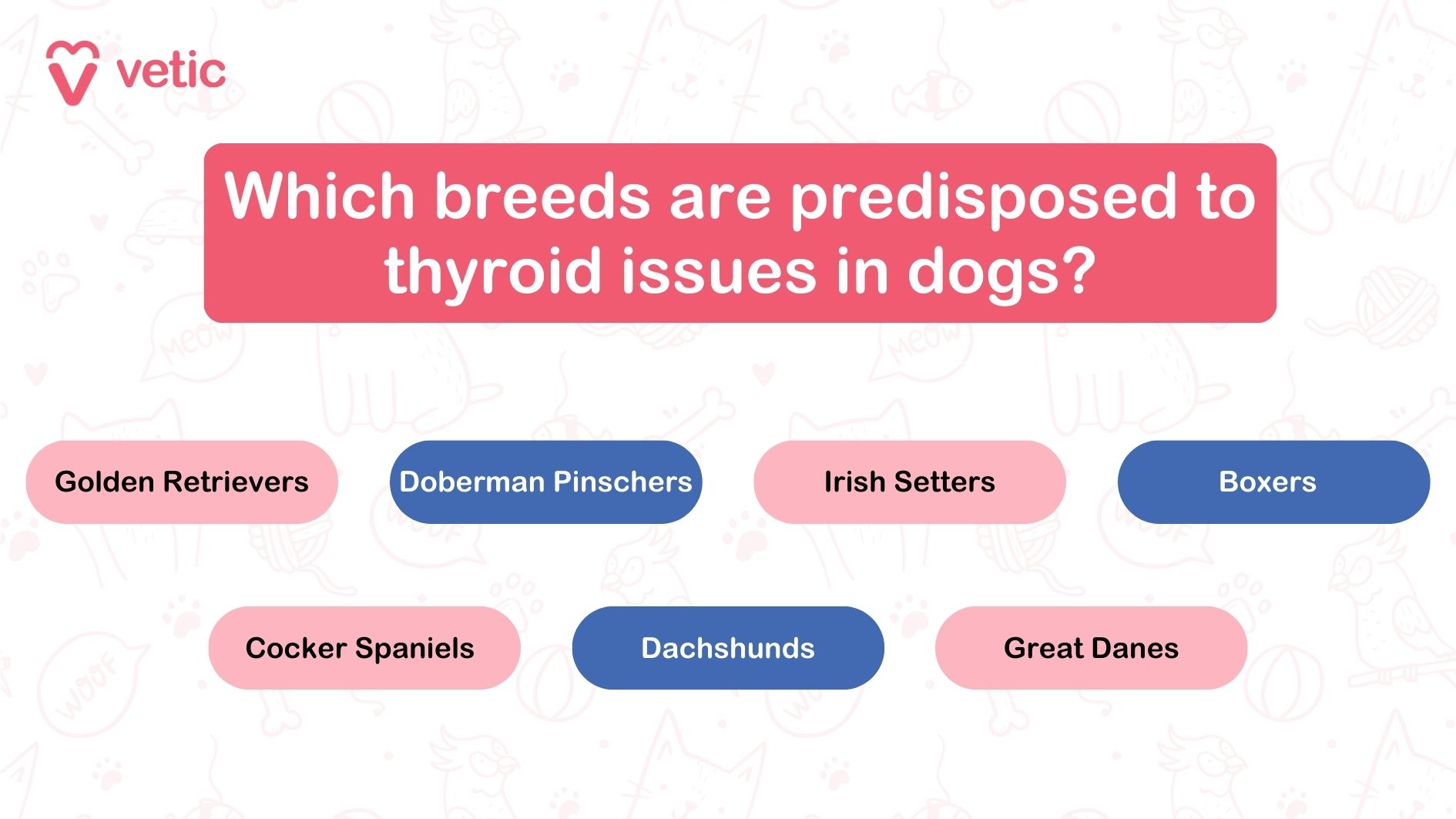
Thyroid disease or hypothyroidism in dogs is common among middle-aged and senior dogs.
It mostly affects dogs of medium and large breeds.
Some breeds of dogs are predisposed to hypothyroidism, including –
How is Thyroid in Dogs Diagnosed?
After considering the signs and a thorough physical examination, your veterinarian will likely recommend a few blood tests including a complete thyroid profile for your dog.
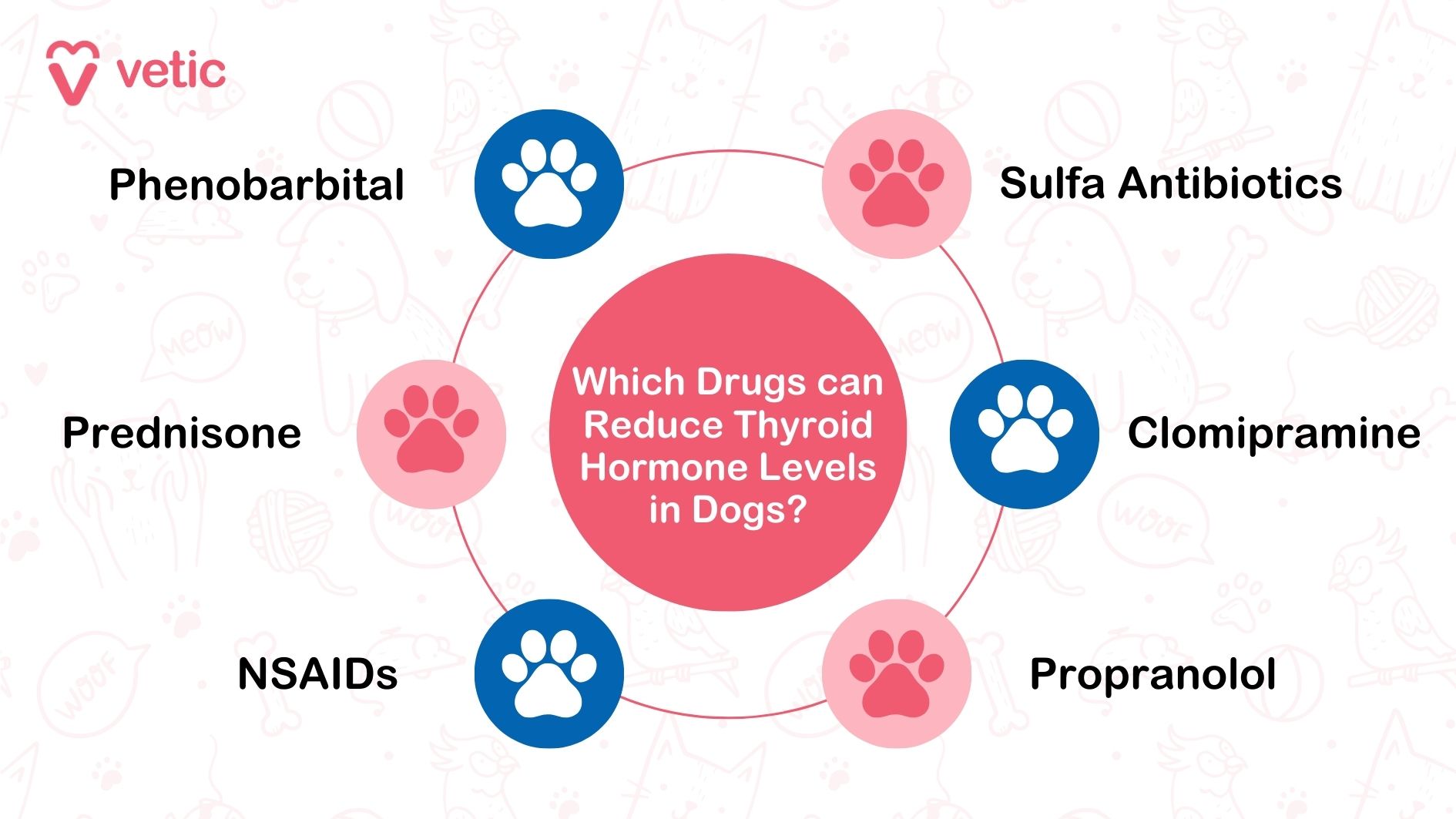
It is important to note that if a dog takes particular medications, they may have lower than normal thyroid hormone levels but not have hypothyroidism. Some of these medications that may cause low thyroxine levels in dogs include –
- Seizure medications (phenobarbital)
- Steroids (prednisone)
- NSAIDs (non-steroidal anti-inflammatory drugs)
- Propanolol (heart medicine)
- Clomipramine (tricyclic antidepressants)
- Sulfa antibiotics
Greyhounds, Whippets and other sighthounds have naturally low thyroid hormone levels as compared to other breeds. Speak to your veterinarian if your pet belongs to a sighthound breed and their thyroid profile test comes back askewed.
The diagnosis of hypothyroidism in dogs is incomplete without considering the complete blood and biochemistry tests of the patient, as well as their medical history. Everything from their diet and breed, to age and co-existing medical conditions.
What is T3, T4 and TSH: Understanding Your Dog’s Thyroid Test Report
Thyroid tests can seem overwhelming, but understanding them is essential if your dog has been diagnosed with or is suspected of having hypothyroidism. Here are the common terms you will find in your dog’s thyroid report.
T3 (Triiodothyronine)
- What it is: T3 is one of the two main thyroid hormones produced by the thyroid gland, although in smaller quantities than T4. It’s the active form of thyroid hormone that affects your dog’s metabolism, energy levels, and overall health.
- How it’s measured: Usually, T3 is measured in two forms—Total T3 (TT3) and Free T3 (FT3), which refers to the T3 not bound to proteins.
- Low T3 in Hypothyroidism: In hypothyroid dogs, T3 levels are often low. However, because T3 can fluctuate, T4 and TSH are more commonly relied upon for a definitive diagnosis.
T4 (Thyroxine)
- What it is: T4 is the primary hormone produced by the thyroid gland and plays a crucial role in metabolism regulation. Most of the T4 in the blood is bound to proteins, while a smaller amount is free to enter tissues and cells.
- How it’s measured: Like T3, T4 is measured as Total T4 (TT4) and Free T4 (FT4).
- Low T4 in Hypothyroidism: Hypothyroid dogs typically have lower T4 levels because the thyroid gland is not producing enough of this hormone.
TSH (Thyroid-Stimulating Hormone)
- What it is: TSH is produced by the pituitary gland, which is in the brain. It tells the thyroid gland to produce more T3 and T4. When the body senses that T3 and T4 levels are low, TSH production usually increases to stimulate the thyroid.
- High TSH in Hypothyroidism: In dogs with hypothyroidism, TSH levels often increase because the pituitary gland is trying to get the underactive thyroid to work harder.
These hormones work in a closed loop and the imbalance of one causes a spike or dip in the others.
T3, T4 and TSH in Thyroid in Dogs
In case of hypothyroidism, there isn’t enough T3. It can happen when there isn’t enough T4. This will result in higher TSH since the thyroid gland isn’t secreting enough hormone.
How to Interpret Your Dog’s Thyroid Test Report?
The following is an example of a thyroid blood test report from a dog with hypothyroidism.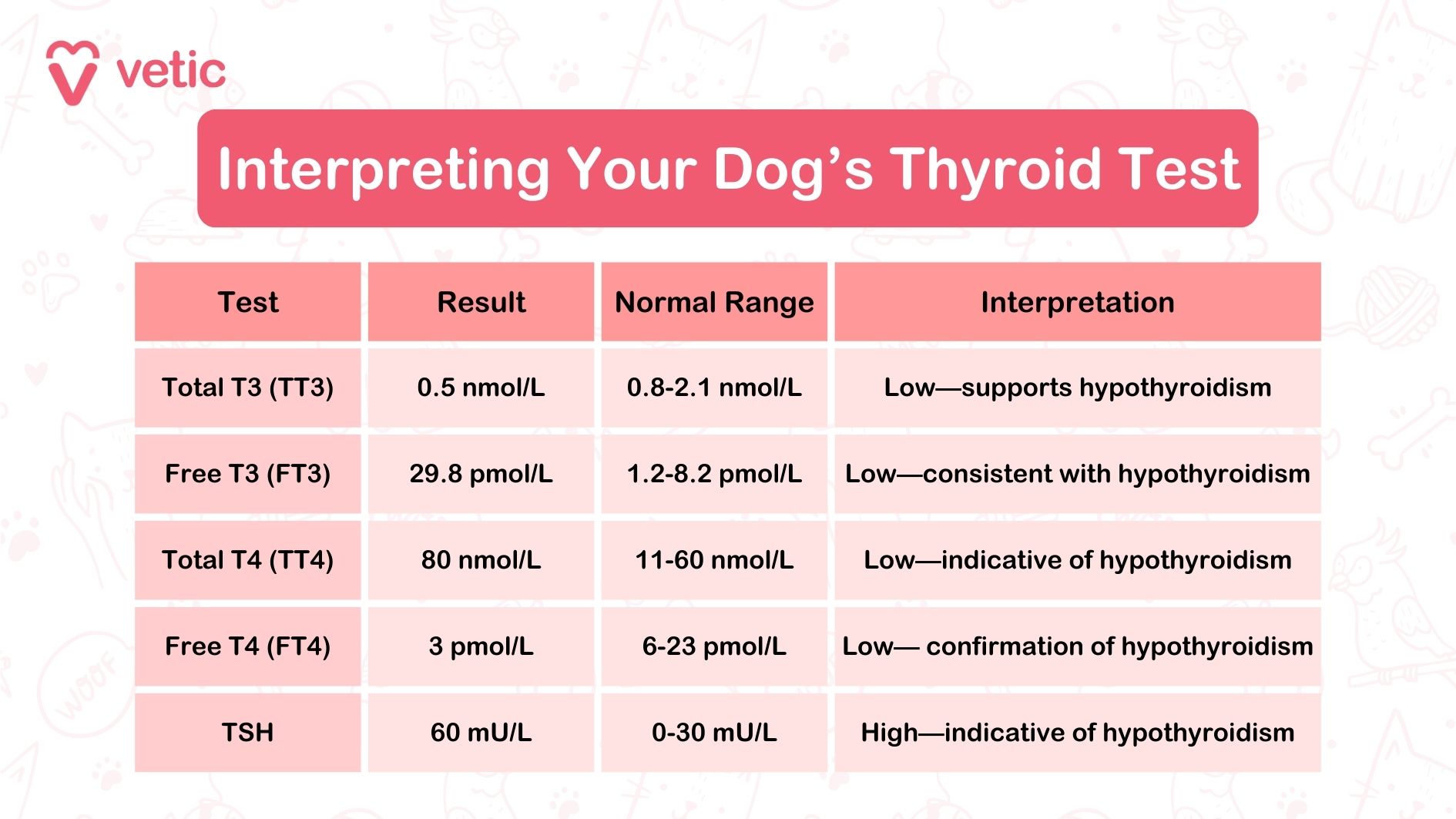
- Total Triiodothyronine (TT3): This measures the total amount of triiodothyronine hormone. This dog’s level is 0.5 nmol/L, which is below the normal range (0.8-2.1 nmol/L). This low level suggests that this dog has very little of this hormone, which is often seen in hypothyroidism.
- Free Triiodothyronine (FT3): This measures the amount of triiodothyronine that is not bound to proteins. This dog’s level is greater than 29.8 pmol/L, which is above the normal range (1.2-8.2 pmol/L). This high level is unusual and may need further investigation.
- Total Thyroxine (TT4): This is a measure of the total amount of thyroxine hormone in the blood. This dog’s level is 80 nmol/L, which is within the normal range (11-60 nmol/L). This means the total amount of thyroxine is normal.
- Free Thyroxine (FT4): This measures the amount of thyroxine that is not bound to proteins and is available to the body’s cells. This dog’s level is 3 pmol/L, which is lower than the normal range (6-23 pmol/L). It is often seen in hypothyroidism.
- Thyroid Stimulating Hormone (TSH): This hormone stimulates the thyroid gland to produce thyroxine and triiodothyronine. This dog’s level is 60 mU/L, which is higher than the normal range (0-30 mU/L). This means the dog has hypothyroidism.
This dog’s thyroid test results show a low level of Total Triiodothyronine (TT3) and a high level of Free Triiodothyronine (FT3), along with a high level of TSH. These findings suggest that this dog may have hypothyroidism, a condition where the thyroid gland does not produce enough thyroid hormones.
What is the Treatment for Thyroid in Dogs?
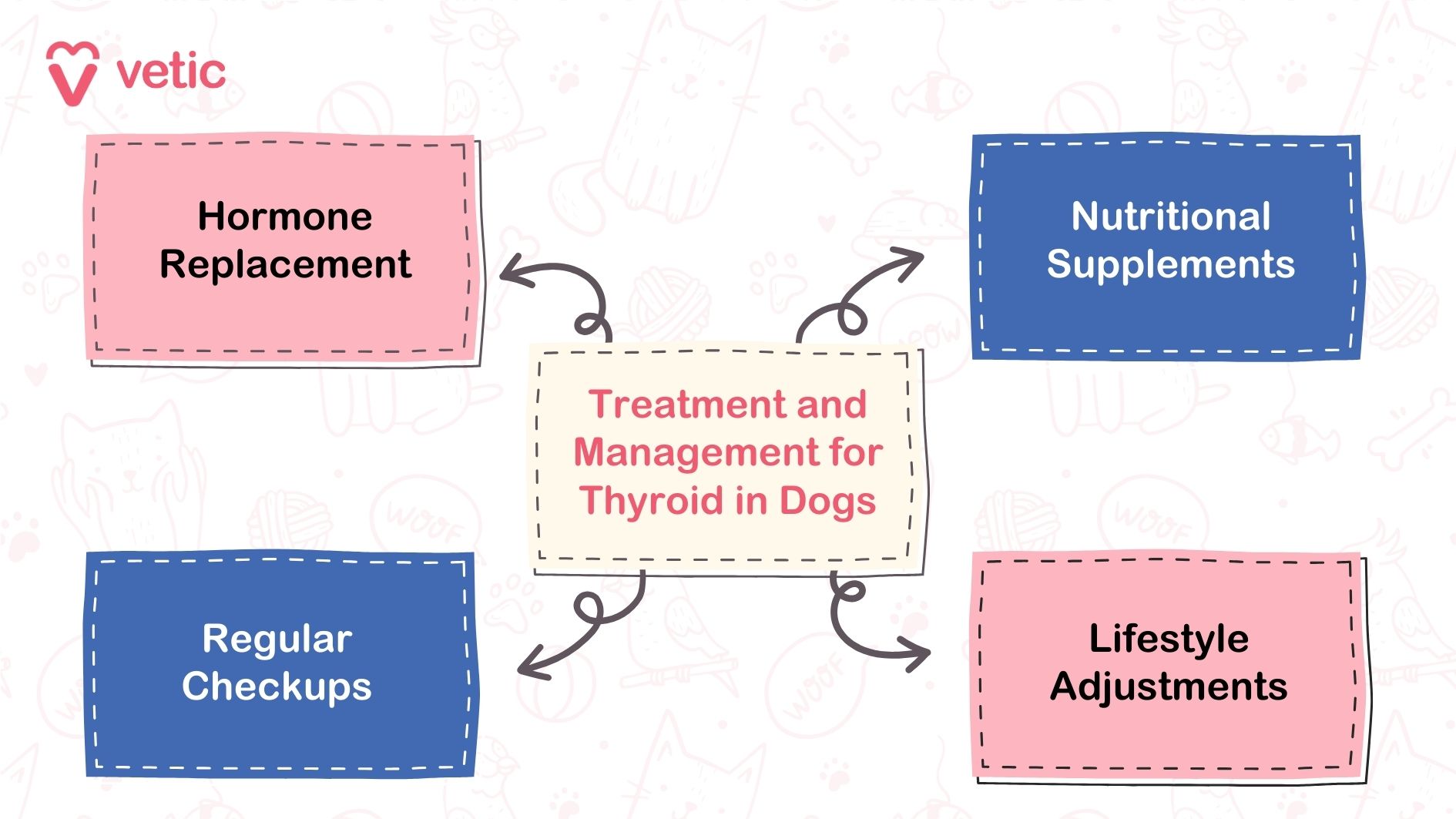
While there is no cure for thyroid in dogs, hypothyroidism can be treated with sustained hormone replacement therapy.
Most veterinarians prescribe a synthetic form of the thyroid (T4 or thyroxine) hormone. These come in the form of tablets and in different strengths.
The veterinarian considers the level of thyroid hormones and the dog’s medical history to calculate the strength and dose of the medicine. Typically, they are given orally, every 12 hours.
For more information, you should consult with your veterinarian since the drug requires close monitoring of the health and wellness for the first few weeks and at least monthly blood tests.
It is common for veterinarians to readjust the strength and dose of the thyroid medication for dogs as per the changes in the T3, T4 and TSH levels of your dog’s blood report.
How Does Thyroid Hormone Replacement Therapy in Dogs Work?
Thyroid hormone replacement therapy (THRT) in dogs works by replenishing the low levels of the thyroid hormone (T4) to a normal level.
Since thyroid in dogs is a chronic condition, the medicine is usually given continuously and for life.
However, the levels of thyroid hormones need to be monitored for dose adjustment. Some dogs may require lower doses of THRT oral medication over the years.
Improvement is measured once the THRT dose is adjusted properly by the veterinarian. You should be able to notice higher energy levels and fewer skin and coat problems within 2 weeks of starting the medication.
Does Levothyroxine Sodium (Used for Treating Thyroid in Dogs) have Any Side Effects?
Oral form of thyroid hormone replacement therapy (THRT) should not have side effects when given in the correct strength and dose. However, some pet parents report the following side effects of levothyroxine sodium in dogs with hypothyroidism –
- Loss of appetite
- Skin sensitivity
- Low activity levels
- Diarrhoea
- Vomiting
- Increased thirst
- Frequent urination
What Should You Know About Medication for Thyroid in Dogs?
Medication for thyroid in dogs such as levothyroxine sodium should ONLY be given as per the strength and dose prescribed by your veterinarian after extensive thyroid profile testing and physical examination of your dog.
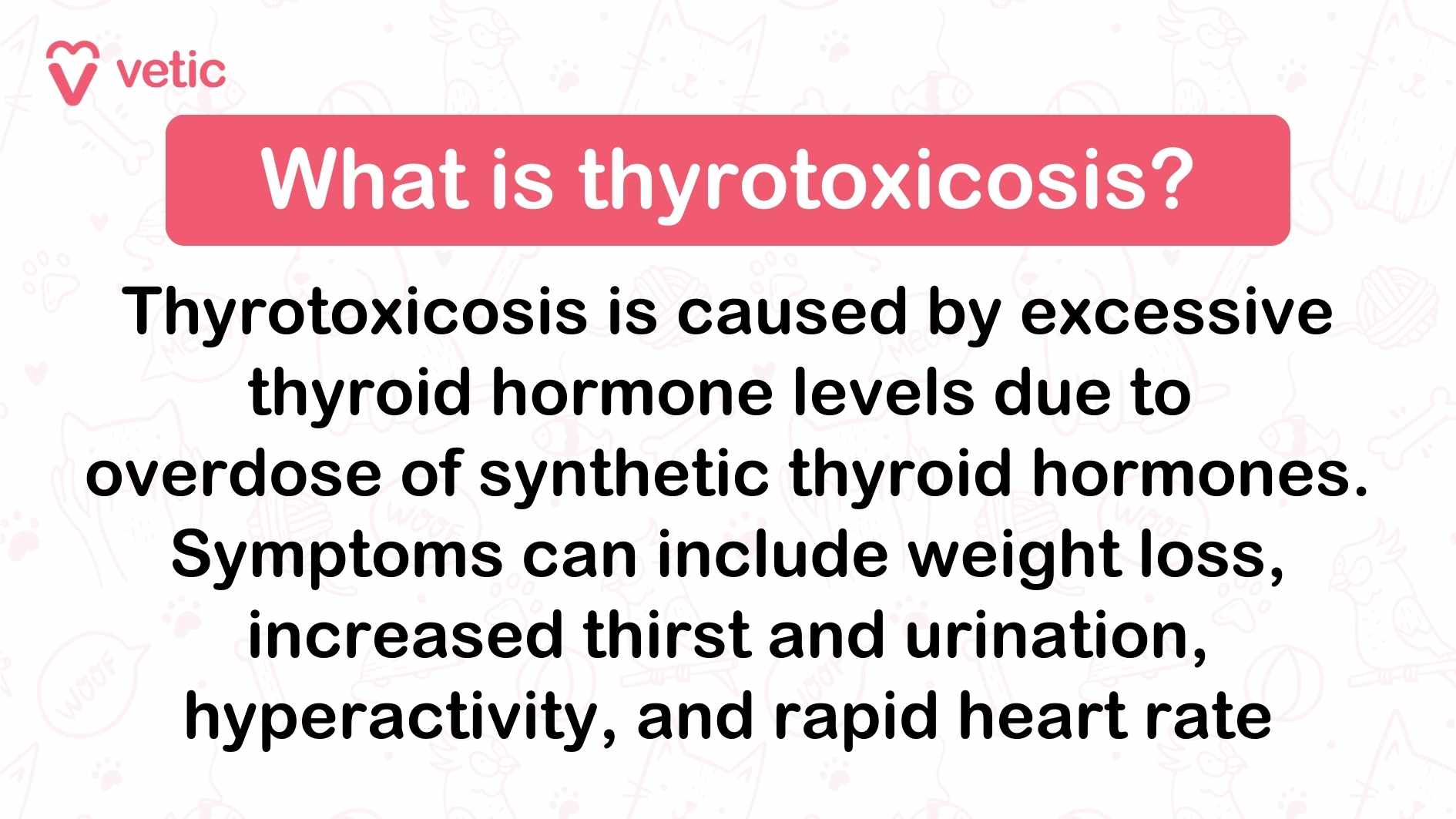 When given at higher than necessary doses, it can cause thyrotoxicosis. It simply means, toxicity from thyroid medication.
When given at higher than necessary doses, it can cause thyrotoxicosis. It simply means, toxicity from thyroid medication.
Thyrotoxicosis can also be caused by an underlying illness that prevents their body from using and absorbing the medication.
The signs of thyrotoxicosis also include –
- Panting and high heart rate
- Hyperactivity and unrest
- Increased appetite
- Increased thirst
- Frequent urination
- Weight loss
Which Dogs Cannot Take Levothyroxine Sodium for Hypothyroidism?
- Any dog who is sensitive to levothyroxine should not be given this medication.
- Dogs with an underactive adrenal gland or hypoadrenocorticism shouldn’t take levothyroxine sodium.
- Dogs that are pregnant or lactating.
Understanding Types of Thyroid Problems in Dogs: Hypothyroidism vs. Hyperthyroidism

Hypothyroidism and hyperthyroidism are key thyroid disorders in dogs, affecting their metabolism and energy. Hypothyroidism, common in dogs, is treated with synthetic hormone supplements like levothyroxine to replace low thyroid hormones. Rare in dogs, hyperthyroidism requires medications that limit hormone production to manage symptoms and prevent overactivity.
FAQs on Thyroid in Dogs
What is thyroid disease in dogs?
Thyroid disease, or hypothyroidism, is a hormonal imbalance where the thyroid gland under-produces the hormone needed for metabolism, leading to lethargy and other issues.
What are the signs of hypothyroidism in dogs?
Common signs include weight gain, low energy, hair thinning, frequent skin infections, and increased sensitivity to cold. Not all signs appear together.
What causes hypothyroidism in dogs?
Hypothyroidism often results from autoimmune thyroiditis, where the immune system attacks the thyroid gland, or an iodine deficiency in homemade diets.
How is thyroid disease diagnosed in dogs?
Vets use blood tests to check thyroid hormones (T3, T4) and TSH levels. Medication history and breed are also considered for accurate diagnosis.
Can thyroid disease be treated in dogs?
Yes, hypothyroidism is treated with lifelong hormone replacement therapy, usually a synthetic thyroid hormone (T4) given in tablet form.
What is the role of T3, T4, and TSH in diagnosis?
T4 is the main hormone produced by the thyroid. T3 is its active form, while TSH stimulates the thyroid. Their levels help confirm hypothyroidism.
Are there side effects of thyroid medication?
Correctly dosed medication usually has minimal side effects, but in some cases, dogs may experience increased thirst, vomiting, or appetite changes.
Can all dogs take thyroid medication?
No, dogs sensitive to levothyroxine, or those with other glandular issues, like adrenal problems, should avoid this medication unless advised by a vet.
